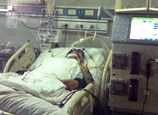
"The data have continued a stabilizing growth trend that took shape late last year, showing that the new government does not put pursuing growth as its number-one task," said Wang Jun, an economist at the China Center for International Economic Exchanges.
The 7.9-percent growth seen in the fourth quarter of last year, which ended a seven-straight-quarter slowdown, had then prompted strong expectations for the rebound to continue this year.
The first-quarter growth fell short of market expectations due to slowed infrastructure construction during the cold winter and unstable export growth. A government frugality campaign, which targets to combat corruption, has undermined consumption growth, Wang said.
The recently renewed government property control has also affected investment in the real estate sector, which once served as an important driver of the economy.
The government has been cautious in introducing policies to spur the economy for fear that a massive stimulus package like the one in 2008 crisis would retrigger inflation. It stopped cutting interest rates late last year and resorted to increasing construction investment to shore up growth.
Because the government has said it will work to make real growth in tandem with the potential rate, which is estimated to be dropping from around 10 percent to 7-8 percent, there is no need for a strong government push, said Zhang Liqun, an analyst from the Development Research Center of the State Council.
"The economy's future growth rates are likely to stay between 7.5 and 8 percent, with the rates in a state of fluctuation rather than continued rises," Zhang said.
But most economists projected slightly higher growth in the second quarter as more measures will be introduced from the new government.
Liu Yuanchun, an economist with Renmin University of China, said that the government should focus on promoting urbanization and tax reduction to prop up the economy in the short term and deepen its political and economic reforms to seek long-term development.
Other data released along with the GDP figures on Monday showed that industrial output grew 9.5 percent year on year in the first quarter, down from 11.6 percent recorded last year. Investment in property development grew 20.2 percent, down 3.3 percentage points from a year earlier.
The growth of fixed-asset investment, a measure of government spending on infrastructure, remained unchanged at 20.9 percent compared to a year earlier. Retail sales, a key indicator of consumer spending, rose 12.4 percent, easing from the 14.8-percent pace logged last year.

















 Death toll rises to 14 in central China hotel fire
Death toll rises to 14 in central China hotel fire


![]()
